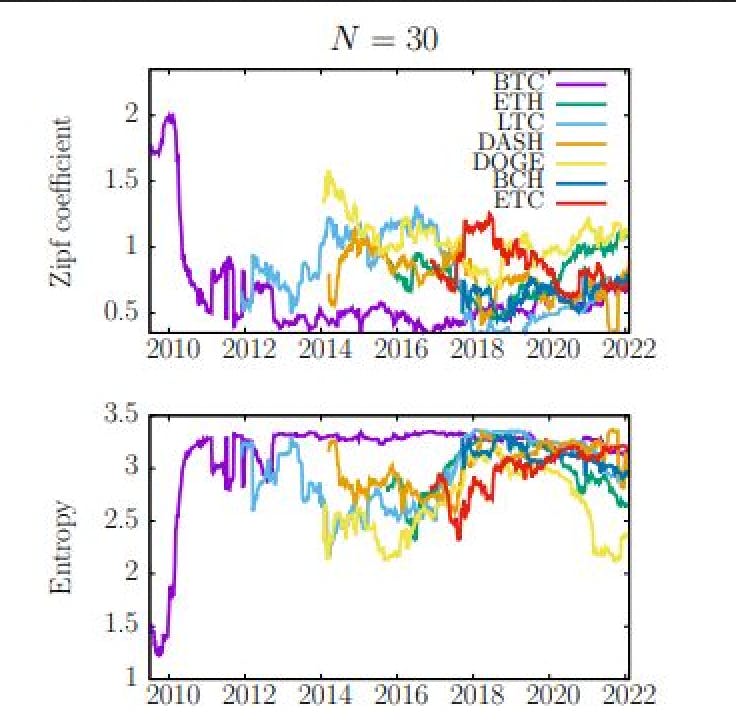This paper is available on arxiv under CC 4.0 license.
Authors:
(1) Bartosz Kusmierz, IOTA Foundation 10405 Berlin, Germany & Department of Theoretical Physics, Wroclaw University of Science and Technology, Poland [email protected];
(2) Roman Overko, IOTA Foundation 10405 Berlin, Germany [email protected].
Table of Links.
IV. SUMMARY
In this article, we analyzed the wealth distribution of the richest addresses in various cryptocurrencies. This included the time evolution of statistical metrics like the approximated Zipf’s law coefficient, Shannon entropy, Gini coefficient, and Nakamoto coefficient, along with their average values. It was shown that coins and ERC20 tokens have quantitatively different distributions of wealth. In particular, the values of approximated Zipf’s law coefficient for coins are 0.4—1.25 and 0.7—2.25 for ERC20 tokens. Differences between the two groups were also apparent during the study of wealth centralization. It was observed that tokens are, in general, much more centralized than coins with higher Gini coefficients and smaller Nakamoto coefficients.
This research might be of particular interest to DAOs and DPoS-based blockchains which rely on some form of a committee of the richest token holders. Presented values of statistical metrics like approximated Zipf coefficient or Nakamoto coefficient might help to model a committee selection process and make it more secure. Future work will evolve in two directions. Firstly, we are working on incorporating more metrics, analyzing more tokens, and considering more different sample size values. Secondly, the main findings of this work will be used to model a committee selection process.
REFERENCES
[1] M. Castro and B. Liskov. Practical Byzantine Fault Tolerance. In Proceedings of the Third Symposium on Operating Systems Design and Implementation, OSDI ’99, page 173–186, USA, 1999. USENIX Association.
[2] W. Chen, T. Zhang, Z. Chen, Z. Zheng, and Y. Lu. Traveling the Token World: A Graph Analysis of Ethereum ERC20 Token Ecosystem. In Proceedings of The Web Conference 2020, WWW ’20, page 1411–1421, New York, NY, USA, 2020. Association for Computing Machinery.
[3] X. Gabaix. Zipf’s Law for Cities: An Explanation. The Quarterly Journal of Economics, 114(3):739–767, 08 1999.
[4] J. R. Jensen, V. von Wachter, and O. Ross. How Decentralized is the Governance of Blockchain-based Finance: Empirical Evidence from four Governance Token Distributions, 2021.
[5] C. I. Jones. Pareto and Piketty: The Macroeconomics of Top Income and Wealth Inequality. Journal of Economic Perspectives, 29(1):29–46, February 2015.
[6] D. Kondor, M. Posfai, I. Csabai, and G. Vattay. Do the Rich Get Richer? ´ An Empirical Analysis of the Bitcoin Transaction Network. PLOS ONE, 9(2):1–10, 02 2014.
[7] S. Kusmierz, Bartosz nd M ´ uller and A. Capossele. Committee Selection ¨ in DAG Distributed Ledgers and Applications. In K. Arai, editor, Intelligent Computing, pages 840–857, Cham, 2021. Springer International Publishing.
[8] D. Larimer. EOS.IO White Paper, 2017. https://github.com/EOSIO/ Documentation/blob/master/TechnicalWhitePaper.md.
[9] D. Lehnberg. Valuing the top 50 Ethereum ERC-20 tokens using Metcalfe’s Law, 2018.
[10] C. Li and B. Palanisamy. Comparison of Decentralization in DPoS and PoW blockchains. In International Conference on Blockchain, pages 18–32. Springer, 2020.
[11] Q. Lin, C. Li, X. Zhao, and X. Chen. Measuring decentralization in bitcoin and ethereum using multiple metrics and granularities, 2021.
[12] A. Miller, Y. Xia, K. Croman, E. Shi, and D. Song. The Honey Badger of BFT Protocols. page 31–42, 2016.
[13] S. Nakamoto. Bitcoin: A Peer-to-Peer Electronic Cash System. 2008.
[14] K. Pietrzak. Simple Verifiable Delay Functions. 2018. https://eprint. iacr.org/2018/627.
[15] S. Somin, G. Gordon, and Y. Altshuler. Network Analysis of ERC20 Tokens Trading on Ethereum Blockchain. In A. J. Morales, C. Gershenson, D. Braha, A. A. Minai, and Y. Bar-Yam, editors, Unifying Themes in Complex Systems IX, pages 439–450, Cham, 2018. Springer International Publishing.
[16] S. Somin, G. Gordon, A. Pentland, E. Shmueli, and Y. Altshuler. ERC20 Transactions over Ethereum Blockchain: Network Analysis and Predictions, 2020.
[17] C. Stathakopoulou, T. David, and M. Vukolic. Mir-BFT: HighThroughput BFT for Blockchains. 06 2019.
[18] E. Syta, P. Jovanovic, E. K. Kogias, N. Gailly, L. Gasser, I. Khoffi, M. J. Fischer, and B. Ford. Scalable Bias-Resistant Distributed Randomness. In 2017 IEEE Symposium on Security and Privacy (SP), pages 444–460, 2017.
[19] F. Victor and B. K. Luders. Measuring Ethereum-Based ERC20 Token ¨ Networks. In I. Goldberg and T. Moore, editors, Financial Cryptography and Data Security, pages 113–129, Cham, 2019. Springer International Publishing.
[20] C. Wang, X. Chu, and Y. Qin. Measurement and Analysis of the Bitcoin Networks: A View from Mining Pools. In 2020 6th International Conference on Big Data Computing and Communications (BIGCOM), pages 180–188, 2020.
[21] B. Wesolowski. Efficient verifiable delay functions. 2018. https://eprint. iacr.org/2018/623.
[22] K. Wu, S. Wheatley, and D. Sornette. Classification of Cryptocurrency Coins and Tokens by the Dynamics of Their Market Capitalizations. Royal Society Open Science, 5(9):180381, 2018.
[23] G. K. Zipf. Selected Studies of the Principle of Relative Frequency in Language. Harvard University Press, 2013.

